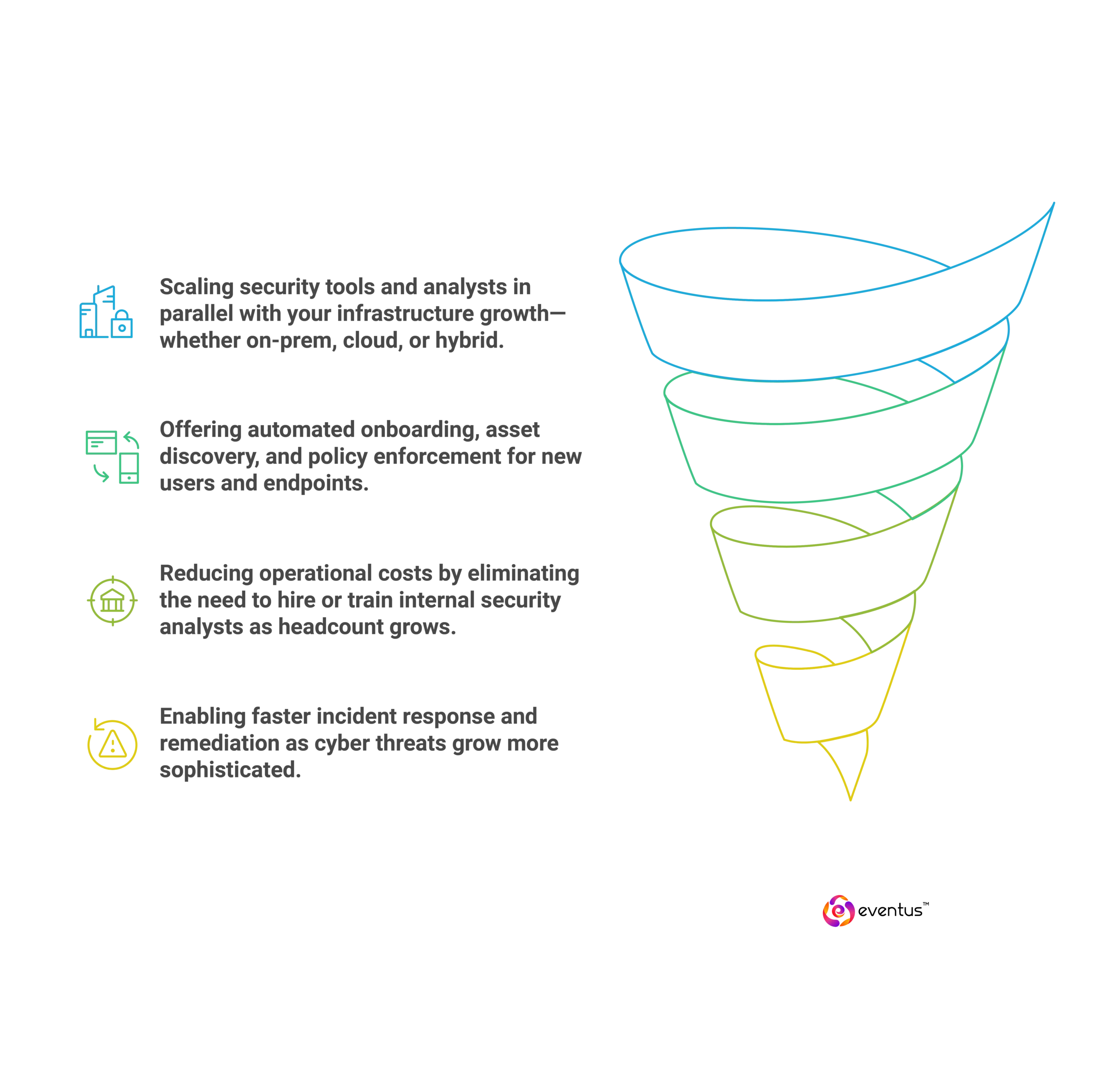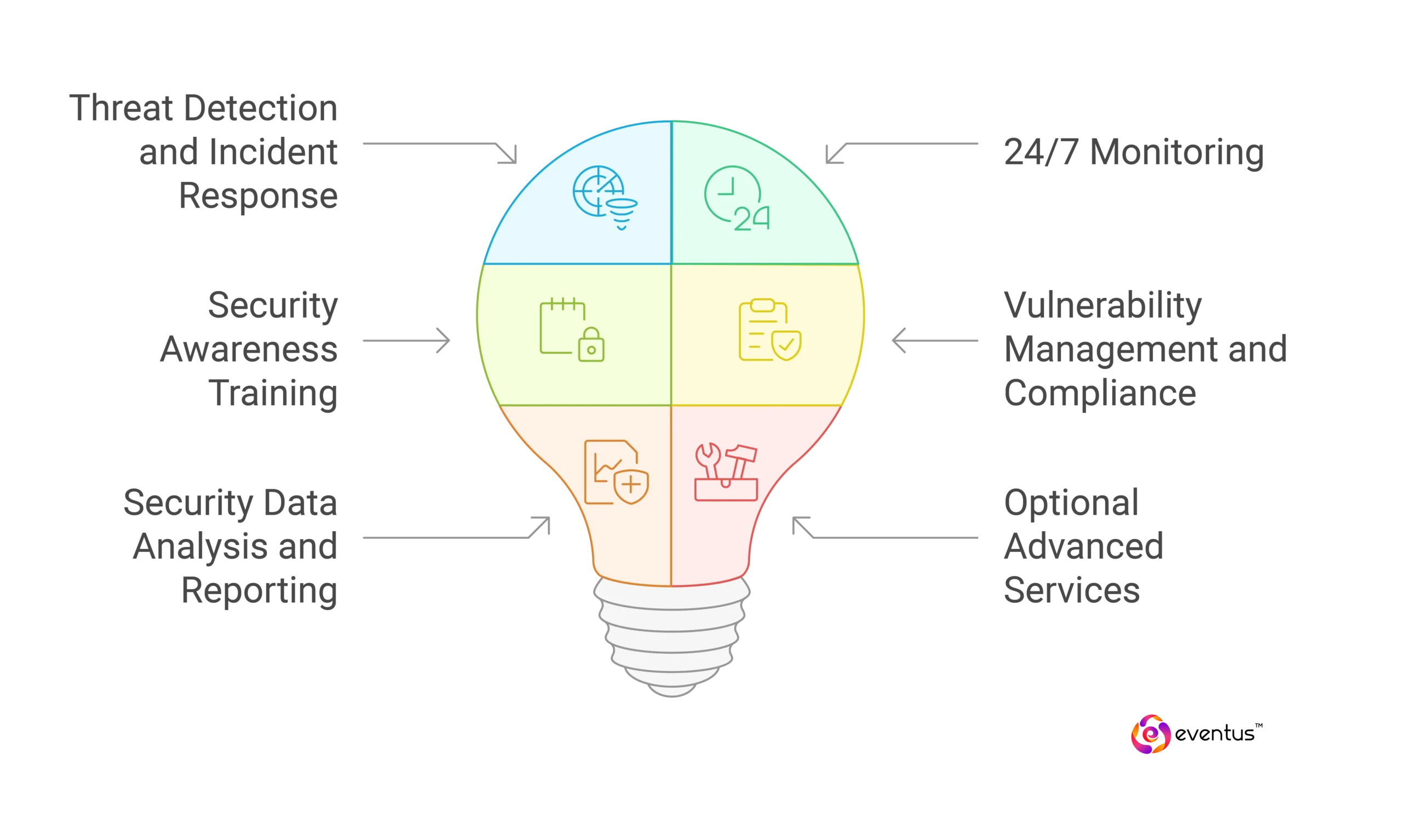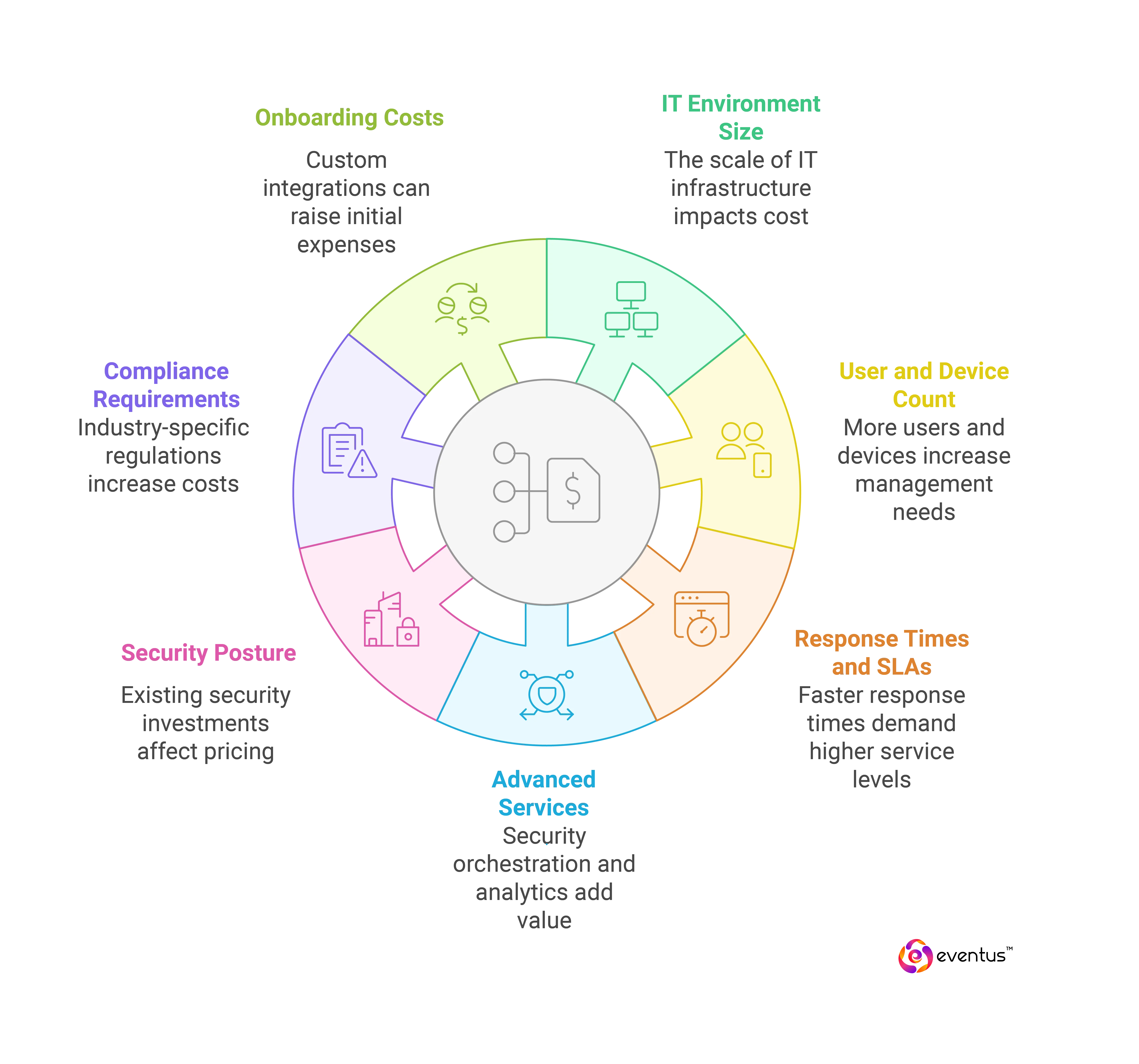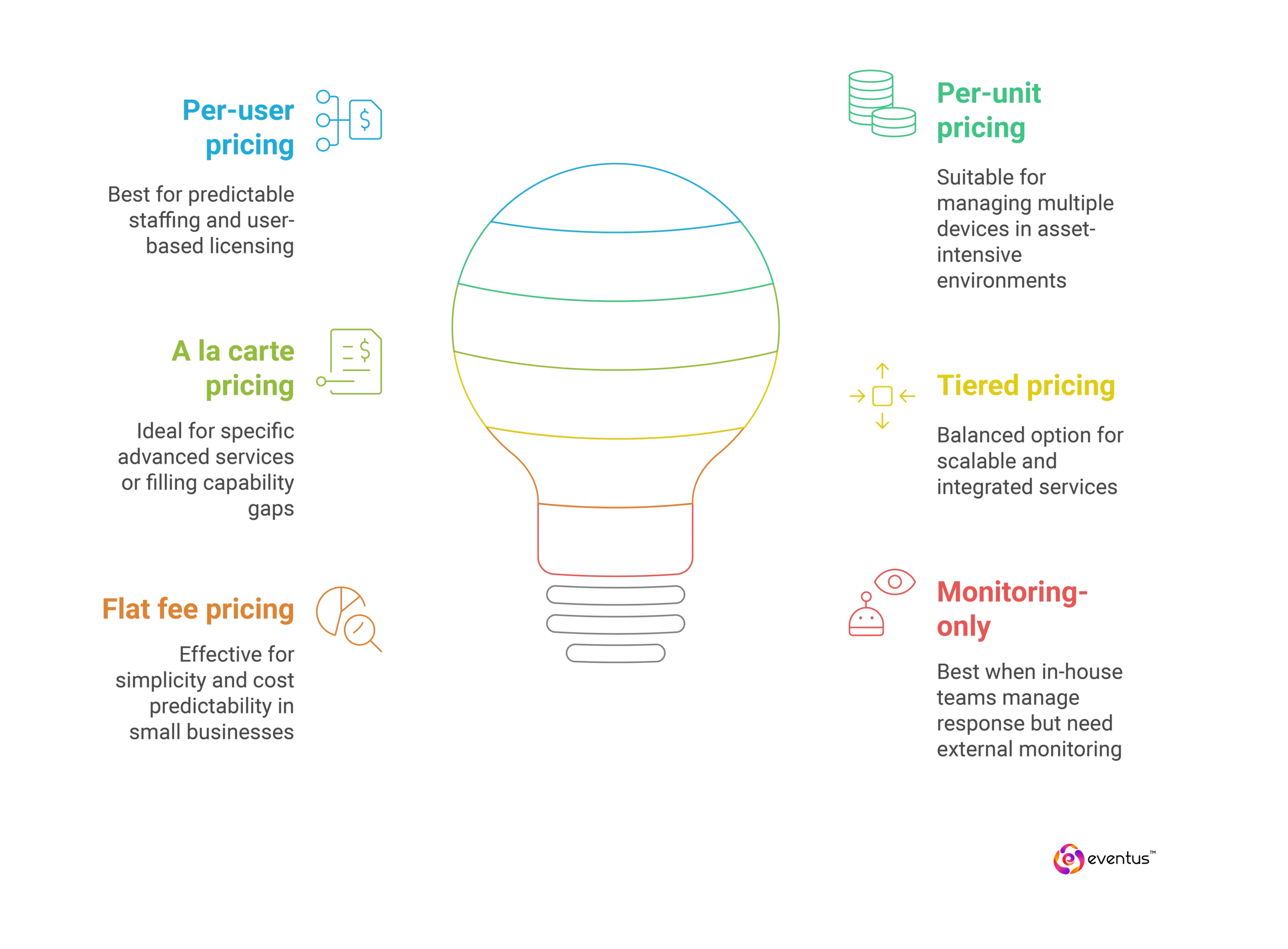This article explores MSSP pricing in detail, beginning with the definition of a Managed Security Service Provider. It outlines what’s typically included in MSSP pricing, why businesses prefer MSSPs over in-house teams, and what typical MSSP costs look like. It also examines key factors influencing MSSP pricing models, helping businesses evaluate cost structures, service levels, and scalability when choosing the right cybersecurity partner.
Table of Contents
What does MSSP stand for?
MSSP stands for Managed Security Service Provider. These providers deliver outsourced monitoring, management, and support for an organization’s security infrastructure. MSSPs operate round-the-clock Security Operations Centers (What is SOC), providing advanced cybersecurity services such as threat detection and response, vulnerability management, incident response, and ongoing remediation.
In India, managed SOC providers like Eventus Security, a leading SOC as a Service provider have demonstrated real-world outcomes— reducing mean time to detect (MTTD) by over 65% across mid-sized BFSI clients in Mumbai and Bangalore. This highlights the operational value of combining automated response with expert-driven incident remediation under a managed SOC framework.
How do MSSPs support fast-growing companies?
Growth introduces scale, which in turn increases attack vectors, compliance exposure, and operational complexity. MSSPs assist fast-scaling companies by:
- Scaling security tools and analysts in parallel with your infrastructure growth—whether on-prem, cloud, or hybrid.
- Offering automated onboarding, asset discovery, and policy enforcement for new users and endpoints.
- Reducing operational costs by eliminating the need to hire or train internal security analysts as headcount grows.
- Enabling faster incident response and remediation as cyber threats grow more sophisticated.
As per CERT-In, India's national nodal agency for cybersecurity, the number of reported cyber incidents reached 1.3 million in 2022, a clear signal for enterprises to adopt continuous monitoring via MSSPs. Advanced MSSPs in India now align their security controls with CERT-In’s advisory compliance, ensuring timely breach reporting and audit-readiness for clients operating in regulated industries.
What are the signs your business needs an MSSP?
A business should evaluate MSSP services when internal resources are misaligned with the growing volume, complexity, or urgency of cyber threats. According to industry estimates by IDC India, managed security services adoption among Indian mid-sized enterprises is growing at 20.6% CAGR (2023–2026), with cost predictability cited as a key driver. For instance, a Delhi-based SaaS company reduced breach remediation costs by over ₹60 lakhs ($73 USD) annually by switching from in-house security to a per-device MSSP model offered by an NCR-based provider. Critical signs include:
- Increased frequency of security incidents with limited ability to investigate or respond.
- A lack of 24/7 monitoring or inability to deploy and manage a functional SOC.
- Inability to manage multiple devices or endpoints across distributed environments.
- Difficulty maintaining security tools, rulesets, and detection logic with an understaffed team.
- Rising costs of in-house security operations without measurable ROI or threat mitigation.
What is included in MSSP pricing?
MSSP pricing is typically structured around a tiered pricing model, with costs varying based on the depth and breadth of services required. Core components generally include:
- Threat detection and incident response across endpoints, networks, and cloud environments. Top-tier Indian MSSPs like Quick Heal Technologies (Seqrite Enterprise Suite) and Inspira Enterprise are recognized for delivering endpoint protection, SIEM management, and threat intelligence as per NASSCOM-DSCI Cybersecurity Task Force standards. Their partnerships with public sector banks and telecom firms demonstrate proven authority in managing large-scale cyber defense ecosystems.
- 24/7 monitoring via SOC teams or automated systems
- Security awareness training for employees
- Vulnerability management and compliance support
- Security data analysis and reporting on security events
- Optional advanced services such as penetration testing, firewall management, and
What affects MSSP pricing structures?
Several variables influence MSSP pricing:
- Size and complexity of the organization’s IT environment
- Number of users and devices under management
- Required response times and service level agreements (SLAs)
- Inclusion of advanced services like security orchestration, automation, and real-time analytics
- The organization’s security posture, including prior investments in tools and controls
- Compliance requirements specific to industries like healthcare or finance
- Onboarding costs, especially for custom integrations or legacy systems
What are the Types of MSSP Pricing Models?
Below is a breakdown of the primary MSSP pricing models, structured for clarity and decision-making.
1. Per-user MSSP pricing
Per-user MSSP pricing is calculated based on the number of individual users within the organization who require cybersecurity coverage.
- Typically charged per user per month.
- Ideal for organizations with a stable headcount and clearly defined user roles.
- Helps align MSSP cost directly with organizational growth or reduction.
- Suitable for businesses where each user interacts with sensitive data, requiring endpoint protection and monitoring.
2. Per-unit MSSP pricing
Per-unit or per-device pricing is based on the total number of assets (e.g., endpoints, servers, network devices) to be secured.
- Pricing is based on the number of devices or specific unit types such as firewalls, routers, or cloud instances.
- Offers flexibility for businesses using multiple devices across departments or locations.
- Supports organizations with variable infrastructure sizes.
3. A la carte MSSP pricing
A la carte MSSP pricing enables businesses to select specific security services based on their unique requirements.
- Services such as SOC monitoring, incident response, vulnerability scanning, and remediation are offered individually.
- Allows organizations to tailor MSSP services to specific security needs without paying for unused features.
- Often used by businesses with in-house security teams seeking to outsource only certain advanced services.
4. Bundled or tiered MSSP pricing
Bundled or tiered pricing offers service packages at predefined levels, such as Basic, Advanced, and Enterprise.
- Each tier provides a different level of service, typically defined by coverage, automation, response times, and number of security events handled.
- Offers predictable MSSP cost and easy comparison across MSSPs.
- Enables businesses to match service level to risk profile and security posture.
5. Flat fee MSSP pricing
Flat fee pricing involves a fixed monthly or annual fee, regardless of user or device count.
- Simplifies budgeting by offering predictable, all-inclusive MSSP pricing.
- Suitable for smaller organizations with stable infrastructure and fewer security events.
- May include limitations in service level or advanced threat detection features.
6. Monitoring-only MSSP pricing
Monitoring-only pricing restricts the MSSP’s role to real-time threat detection and alerting, without active incident response or remediation.
- Lower MSSP cost due to exclusion of response capabilities.
- Ideal for companies with an in-house team capable of managing security incidents post-detection.
- Often used to complement internal SOC operations or SIEM tools.
Which MSSP pricing model is best for my business?
Selecting the right pricing model depends on multiple factors including infrastructure complexity, in-house capabilities, compliance needs, and budget tolerance.
Consider the following:
- Per-user pricing: Best for organizations with predictable staffing and user-based licensing models.
- Per-unit pricing: Suitable for asset-intensive environments managing multiple devices.
- A la carte pricing: Ideal for businesses needing specific advanced services or filling in-house capability gaps.
- Tiered pricing: Balanced option for businesses of all sizes seeking scalable and integrated managed security services.
- Flat fee pricing: Effective for small businesses needing simplicity and cost predictability.
- Monitoring-only: Best when in-house teams can manage response but require external monitoring.
How Does AI Impact MSSP Pricing Models?
The integration of artificial intelligence (AI) is fundamentally reshaping how Managed Security Service Providers (MSSPs) approach their pricing models, operational strategies, and service offerings. By enabling predictive analytics, process automation, and dynamic risk evaluation, AI introduces both cost efficiencies and enhanced precision into managed security services pricing.
- AI enables dynamic MSSP pricing by automating service scaling based on real-time factors like number of devices, threat exposure, and security posture, allowing for flexible per-user or per-device billing models.
- Operational efficiency improves through AI-driven automation of threat detection, log analysis, and incident response, reducing manual effort and lowering overall MSSP costs while enhancing ROI.
- SOAR tools (Security Orchestration, Automation, and Response) are increasingly deployed by MSSPs to streamline threat remediation workflows, reduce analyst fatigue, and standardize incident handling, thereby lowering response time and operational cost. These tools integrate seamlessly with SIEM systems, enabling higher service consistency and enabling outcome-based pricing.
- SaaS-based AI tools empower MSSPs to deliver scalable, cloud-native security services with automated monitoring, remediation, and billing logic integrated into subscription frameworks.
- Automation plays a central role in reducing in-house security dependency, streamlining multi-device management, and accelerating response times, directly influencing managed security services pricing.
- AI enhances service delivery quality by enabling continuous security posture evaluation, proactive threat mitigation, and 24/7 monitoring, helping MSSPs offer consistent, high-value protection across business sizes.
How much do MSSPs in India typically cost?
The MSSP cost in India varies widely based on several factors:
1. Per-user pricing
- ₹1,660 ($19.28 USD) to ₹8,300 ( $96.72 USD )+ per user/month
- Indian MSSPs offering this model: Inspira Enterprise, Seqrite (Quick Heal Enterprise), SISA, Eventus Security
- Suitable for organizations focusing on user-centric security controls, such as DLP, IAM, and endpoint protection.
2. Per-device pricing (firewalls, endpoints)
- ₹4,150 ($48.50 USD) to ₹16,600 ($193.72 USD) per device/month
- Adopted by MSSPs managing EDR, NDR, or firewall appliances (e.g., Kratikal, Lucideus, Eventus Security)
- Effective for infrastructure-heavy environments with distributed offices, hybrid cloud, or BYOD policies.
3. Flat-rate or tier-based pricing
- Common monthly plans range between ₹1,00,000 ($1,163 USD) and ₹10,00,000 ($12,048 USD)
- Depends on the number of endpoints, log volume, SIEM integrations, and compliance requirements (e.g., PCI DSS, HIPAA, ISO 27001)
- Offered by enterprise MSSPs like CtrlS, Netmagic (NTT), and Tata Communications for medium to large enterprises.
4. Custom/Enterprise MSSP pricing
- Typically starts at ₹15,00,000/month ($18,000 USD) or more for:
- 24/7 SOC as a Service
- Dedicated security analysts
- Threat hunting, automation, and compliance audits
- Relevant for regulated industries, BFSI, and IT/ITES sectors.
Providers: Eventus Security, Paladion (now Atos), Tech Mahindra Cybersecurity Services







